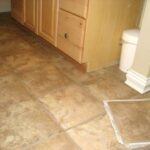Recently the time came for us to either repair or replace the ceramic tiles on our bathroom floor. Our home’s previous owners had installed ceramic tile on the bathroom floor, and while we like it, age has led to some of the ceramic tiles being broken and the grout is breaking apart. So the choice we had to make for our bathroom floor, was to repair those broken tiles and regrout the places where tiles were loosened or replace the entire floor covering with something different.
To repair the broken ceramic tiles on our bathroom floor required finding more of the same tiles(keep in mind this floor was put in over 20 years ago) and matching the grout color as well.
To replace the ceramic tile floor in this bathroom with something different presented other options. More ceramic tile? Vinyl covering? Vinyl tiles?
To make our decision on what path to take in redoing our bathroom floor, we had to consider several factors. Since we were doing this bathroom floor project ourselves, the level of difficulty and expertise needed was one factor to consider. Another factor was, of course, expense. How much money were we willing and able to put into this bathroom floor? Weighing all of our options and factors, we decided to replace the bathroom ceramic tile completely; to take up the existing ceramic tile and replace it with vinyl tile flooring.
Vinyl tile flooring for the bathroom was both the least expensive option we considered ,and apparently the easiest. It is not the bathroom flooring option with the longest-lasting rate, but we were looking for pleasing to look at, functional, cheap and fast at the time of this bathroom floor project.
The vinyl tile flooring option having been decided upon, we first set out to choose which vinyl tiles we liked the best. Amazingly, finding and agreeing on the style/look of the vinyl tiles for our bathroom floor did not take us long at all. Again, this flooring option is not the best rated for long term durability, but for a cheap, attractive bathroom floor it works.
So now that we had decided on the vinyl tiles for our bathroom floor and chosen our particular design, it was time to gather all the tools and items needed to replace our bathroom floor covering.These days, most vinyl tile flooring is self-adhesive-literally peel-and-place stickers-so dealing with gooey, slow-drying adhesive on our bathroom floor was not something we were going to have to deal with in this project. In fact, the instructions for placing and adhering these self-stick vinyl tiles adamantly insist that you do not add any adhesive beyond what is already there.
The first step in replacing our bathroom floor covering was to take up, to remove the existing ceramic tile flooring. This job was not as difficult as it could have been in that several of the ceramic tiles were already broken and loose and the old grout was already cracked and broken in other places on our bathroom floor. We began with picking up those broken tiles and pieces of grout. Once that was done, there were still quite a few of the ceramic floor tiles firmly in place. These had to be loosened and removed. Using a chisel and a hammer, we pried the tiles loose one by one. It is very important to wear eye protection during this part of the ceramic tile removal. Gloves for hand protection are a plus in that the ceramic floor tiles and the grout can be abrasive and even sharp.
Once all the ceramic floor tiles and grout were loosened and removed, the next part of replacing our bathroom floor covering was to clean the floor well. Before installing the new floor covering, the subfloor we just uncovered must be completely clean and free of debris. Any tiny particles of grout, dust and the like will interfere with the adhesive of the new floor covering therefore causing adherence problems and even lumps or bumps in the new floor surface. Broom sweeping and vacuuming several times should get the surface of the floor clean and smooth, ready for installation of the new bathroom floor covering.
Since we used self-adhesive vinyl floor tiles, we did not need to have any floor adhesive on hand. However, due to some small damaged spots on the subfloor, under the ceramic tile, we did have some repair work to do before placing the new vinyl tiles. Using a putty-like floor patch mixture and a spatula for this purpose, we smoothed this over the damaged places in the bathroom floor and allowed it to dry completely over night. This was probably the most time-consuming part of the whole floor replacing project. Or, at least, it seemed like it because there was nothing else to be done in the meantime except wait. Once this dried, we sanded it smooth and we were ready to install the new floor covering in our bathroom.
The self-adhesive vinyl tiles were a cinch to place on the smooth, debris free floor. Careful measuring was needed to ensure the proper fit, some tiles had to be cut to a particular size/dimension to fit in the necessary spaces, but overall the actual installation of our new vinyl tiles in the bathroom was a problem-free, smoothly executed project that took less than two days to complete.



